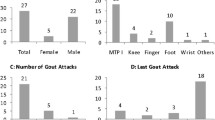Abstract
The purpose of this article is to summarise the early musculoskeletal complications of acromegaly. Some of the early signs of acromegaly may be evaluated by the musculoskeletal radiologist. In the early stage of disease, peripheral nerve enlargement associated with carpal tunnel syndrome or cubital tunnel syndrome and thickening of retinacula, such as A1 pulley in trigger finger, represent the features that may be seen by radiologists and are worthy of an endocrinological evaluation. Due to the insidious nature of the disease, the diagnosis of acromegaly is significantly delayed. Few and nonspecific symptoms characterise the initial phases of the disease, and therefore, most patients will have generally consulted many specialists (most frequently musculoskeletal radiologists) before an adequate endocrinological assessment is performed. For this reason, initial clinical signs are much more important than symptoms for an early diagnosis of acromegaly. The first and most important therapeutic approach to acromegaly is early diagnosis, whereas the therapeutic goals are to eliminate morbidity and reduce mortality to the expected age- and sex-adjusted rates and prevent the development of systemic complications. Musculoskeletal radiologists should be aware that these features may be early manifestations of acromegaly. When both radiological and clinical abnormalities are present, an endocrinological workup is useful to diagnose the disease in an early phase.
Riassunto
L’obiettivo del lavoro è di riassumere le complicanze precoci dell’acromegalia. Tra i segni precoci dell’acromegalia alcuni possono essere riconosciuti dal radiologo muscolo-scheletrico. Nelle fasi precoci della malattia l’ingrandimento dei nervi periferici associato alla sindrome del tunnel carpale o del tunnel cubitale e l’ispessimento dei retinacoli come la puleggia A1 nel dito a scatto rappresentano i segni che possono essere notati dal radiologo e che meriterebbero una valutazione specialistica endocrinologica. La diagnosi di acromegalia è tipicamente ritardata dalla natura insidiosa della malattia. Nelle fasi iniziali i sintomi possono essere pochi e aspecifici, pertanto i pazienti consultano molti specialisti, tra cui il radiologo muscolo-scheletrico, prima di effettuare una visita specialistica endocrinologica. Per questo motivo, per una diagnosi precoce, i segni clinici iniziali sono importanti più dei sintomi clinici aspecifici. Dato che gli obiettivi terapeutici sono la riduzione della morbilità e della mortalità, la diagnosi precoce rimane il miglior approccio terapeutico possibile per prevenire le complicanze sistemiche.
Similar content being viewed by others
References/Bibliografia
Ben-Shlomo A, Melmed S (2001) Acromegaly. Endocrinol Metab Clin North Am 30:565–583
Colao A, Ferone D, Marzullo P et al (2004) Systemic complications of acromegaly: epidemiology, pathogenesis and managment. Endocr Rev 25:102–152
Marie P (1886) Sur deux cas d’acromegalie. Rev Med 6:297–299
Reid TJ, Post KD, Bruce JN et al (2010) Features at diagnosis of 324 patients with acromegaly did not change from 1981 to 2006: acromegaly remains under-recognized and underdiagnosed. Clin Endocrinol (Oxf) 72:203–208
Colao A, Pivonello R, Scarpa R et al (2005) The acromegalic arthropathy. J Endocrinol Invest 28:24–31
Detenbeck L, Tressler H, O’Duffy J et al (1973) Peripheral joint manifestations of acromegaly. Clin Orthoped 91:119–127
Colao A, Marzullo P, Vallone G et al (1998) Reversibility of joint thickening in acromegalic patients: an ultrasonography study. J Clin Endocrinol Metab 83:2121–2125
Holt P (1981) Locomotor abnormalities in acromegaly. Clin Rheum Dis 7:689–709
Fauci AS, Braunwald E, Kasper DL et al (2005) Harrison’s Principles of Internal Medicine. McGrow-Hill, Oxford
Tagliafico A, Resmini E, Nizzo R et al (2008) Ultrasound measurement of median and ulnar nerve cross-sectional area in acromegaly. J Clin Endocrinol Metab 93:905–909
Podgorski M, Robinson B, Weissberger A et al (1988) Articular manifestation of acromegaly. Aust NZJ Med 18:28–35
Baum H, Ludecke DK, Hermann HD (1988) Carpal tunnel syndrome and acromegaly. Acta Neurochir 83:54–55
Jenkins PJ, Sohaib SA, Akker S et al (2000) The pathology of median neuropathy in acromegaly. Ann Intern Med 133:197–201
Kaneyama S, Tanaka R, Hasegawa A et al (1993) Subclinical carpal tunnel syndrome in acromegaly. Neurol Med Chir 33:547–551
Inamura H, Isu T, Iwasaki Y et al (1989) Carpal tunnel syndrome in acromegaly-4-case and review of literature. Hokkaido Igaku Zasshi 64:642–647
Pickett JB, Layzer RB, Levin SR et al (1975) Neuromuscular complications of acromegaly. Neurology 25:638–645
Martinoli C, Schenone A, Bianchi S et al (2002) Sonography of the median nerve in Charcot-Marie-Tooth Disease. AJR Am J Roentgenol 178:1553–1556
Martinoli C, Derchi LE, Bertolotto M et al (2000) US and MR imaging of peripheral nerves in leprosy. Skeletal Radiol 29:142–150
Lee D, Dauphinee DM (2005) Morphological and functional changes in the diabetic peripheral nerve: using diagnostic ultrasound and neurosensory testing to select candidate for nerve decompression. J Am Podiatr Med Assoc 95:433–437
Low PA, McLeod JG, Turtle JR et al (1974) Peripheral neuropathy in acromegaly. Brain 97:139–152
Resmini E, Tagliafico A, Nizzo R et al (2009) Ultrasound of peripheral nerves in acromegaly: changes at 1-year follow-up. Clin Endocrinol (Oxf) 71:220–225
Tagliafico A, Resmini E, Nizzo R et al (2008) The pathology of the ulnar nerve in acromegaly. Eur J Endocrinol 159:369–373
Cutt S (2007) Cubital tunnel syndrome. Postgraduate Med J 83:28–31
Tagliafico A, Panico N, Serafini G et al (2010) The thickness of the A1 pulleys reflects the disability of hand mobility in scleroderma. A pilot study using high-frequency ultrasound. Eur J Radiol, in press
Uotani K, Kawata A, Nagao M et al (2007) Trigger finger as an initial manifestation of familial amyloid polyneuropathy in a patient with Ile107Val TTR. Intern Med 46:501–504
Tagliafico A, Resmini E, van Holsbeeck MT et al (2009) Sonographic depiction of trigger fingers in acromegaly. J Ultrasound Med 28:1441–1446
Author information
Authors and Affiliations
Corresponding author
Additional information
AT and ER contributed equally
Rights and permissions
About this article
Cite this article
Tagliafico, A., Resmini, E., Ferone, D. et al. Musculoskeletal complications of acromegaly: what radiologists should know about early manifestations. Radiol med 116, 781–792 (2011). https://doi.org/10.1007/s11547-011-0671-z
Received:
Accepted:
Published:
Issue Date:
DOI: https://doi.org/10.1007/s11547-011-0671-z




